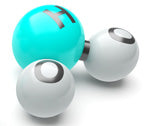Over the years scientists have discovered in nature or produced in their laboratories more than 100 elements. Each of these basic materials has its own peculiar atomic structure. The molecule of an element may consist of one atom or two or more similar atoms. These atoms are inconceivably small. The weight of an oxygen atom, for example, has been determined at 0.000,000,000,000,000,000,000,0266 gram. (There are 453.6 grams in a pound.) Obviously, ordinary units of measurement are insufficient for use in determining the weight of an atom or a molecule.
Scientists have gathered a great mass of significant information on the nature of the atom, both through theoretical study and testing. As a result of their genius, we now have these pics.
Atom
The smallest possible unit of an element. The atom can only be broken down into the fundamental particles of matter, such as the proton, electron, neutron, antiproton, and meson.

Molecules
Molecules consist of two or more atoms of one or more elements. (Cl2) is a molecule of chlorine. (NaCl) is a molecule of salt.
Gram
The gram is the basic unit of weight in the metric system. It is equal to 1/28 of an ounce (.0022046 pound or 15.4324 grains troy). It is meant to be, and virtually is, the weight of distilled water at 4°C contained in a cube whose edge is one-hundredth of a meter (one cubic centimeter). 453.6 g = 1 pound.
As it occurs in nature, oxygen is a mixture of three isotopes-oxygen-16, oxygen-17, and oxygen-18. Over the years, chemists developed a table of atomic weights, with a value of 16 established for this natural mixture. However, because of different needs, physicists developed a separate table based upon the single isotope, oxygen-16. Thus, minor but definite variations existed between the tables. Recently a new table based upon carbon-12 has been adopted, which apparently will be used by both. The atomic weights used in this course are taken from the new table.
Over a century ago, chemists developed a purely relative scale for atomic weights. At the time, they assigned a mass of 16 to the oxygen atom. They then expressed the atomic weight for all other elements in terms relative to the weight of 16 assigned to the oxygen atom.
The hydrogen atom was discovered to weigh approximately 1/16 that of oxygen. Its actual atomic weight is 1.00797.
The weight of molecules can be easily calculated if the formula for a given molecule is known. Simply add the atomic weights of the various atoms that make up the molecule. Here are a few examples of how molecular weight is determined:
|
Substance/Formula Oxygen molecule/O2 |
Computation of Molecular Weight 2 x atomic weight = 2 x 16 = 32 |
Very quickly now we will see the bearing these atomic weights have on this subject of water chemistry.



